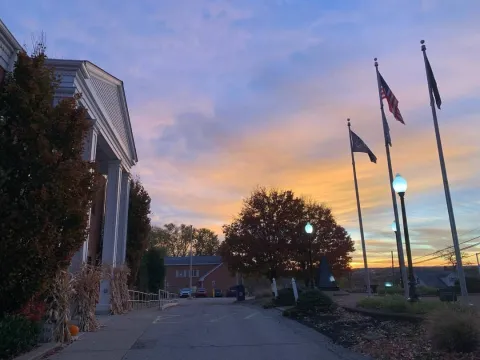North Huntingdon
North Huntingdon Township was settled from the eastern and western ends at approximately the same time. The area that later became known as Irwin was the dividing line between the two sections. The German settlement was on the east and the Scotch-Irish was on the west. In the German settlement, the schools were operated by the Lutheran church, and the German language was taught exclusively. When some progressive members advocated the teaching of English, it caused a conflict that almost broke up the church.
The western or Scotch-Irish Presbyterian settlement occurred mainly in Circleville, Cavitt's Mills, and Robbin's Station. The first white settlers in what is now North Huntingdon Township were Mr. and Mrs. Mathias Cowan, who came in a covered cart in which they lived until building a cabin in the wilderness. Soon after their arrival, Mrs. Cowan's brother, Abner Gray, was captured by the Indians.
Among the earliest settlers were Colonel John Irwin and his brother, James, the Scotch-Irish progenitors of the Irwin family. After arrival in what later became North Huntingdon Township, Colonel Irwin began trading with the Indians. He took up a large tract that included the land on which the present borough of Irwin stands. His brother James settled on the site of Jacksonville (Jacktown). James' son, John, founded the town of Irwin. Not long after the arrival of the Irwins, a large number of other Scotch-Irish Presbyterians settled along Brush Creek and to the north. Among these were the Boyds, Marshalls, Corrys, McCormicks, Osbornes, Simpsons, Temples, Wilsons, and Shaws. Most of them came after the Revolution and before 1796.
The Township of Huntingdon was founded on April 6, 1773. At the same time, newly formed Westmoreland County was subdivided by the townships of Fairfield, Donegal, Hempfield, Pitt, Tyrone, Springhill, Menallen, Rostraver, and Armstrong. The incorporation took place at the first regular session of the Hannastown Court meeting in Robert Hanna's log hotel. The first county seat was located on the Forbes Trail three and a half miles northeast of the present town of Greensburg. Named after a place in England, Huntingdon's boundaries began at the mouth of Brush Run where it empties into Brush Creek. It went along Byerly's Path to Braddock's Road, then continued to the lines that marked the townships of Mount Pleasant, Tyrone, and Pitt. Huntingdon was later divided into smaller townships of North Huntingdon, East Huntingdon, and Sewickly.Shortly after Pontiac's War and the Battle of Bushy Run, a settlement known as Fort Waltour was started in the vicinity of Strawpump and Penglyn. Included among these early settlers were the Marchands, Studebakers, Whiteheads, Willards, Walthours, Sams, Sowashes, Harrolds, Millers, and Kunkles. Many of these early pioneers were of German extraction.
After the Revolutionary War, there were disputes over whether Westmoreland was a part of Virginia or Pennsylvania. Governor Dunmore of Virginia, who claimed the area as part of Virginia, sent raiding parties of Indians and whites dressed as Indians to plague settlers of this region. Frequent attacks and massacres occurred in Huntingdon during the period known as Dunmore's War. Blockhouses were constructed throughout the area to protect the settlers during Indian attacks. Attacks occurred at Fort Walthour, Colonel Irwin's trading post at Brush Hill, Marshall's home at Circleville, the Brush Creek Lutheran Church, Davis's home, and Bryn Mawr. The dispute reached its peak with the burning of Hannastown in 1782.
Violence erupted again in the township during the 1790s, preceding the Whiskey Rebellion. Farmers demonstrated against a tax on the distillation of whiskey, levied to obtain funds to help pay the Revolutionary War debt. A society known as "Tom the Tinker" threatened residents who paid the tax by sabotaging stills. One of the well-known journalists who spoke out against the whiskey tax was George Scull, founder of the Pittsburgh Gazette (now called the Pittsburgh Post-Gazette).Huntingdon's principal stream was Brush Creek, the famous tributary during the seventeen hundreds in the Battle of Bushy Run during Pontiac's Conspiracy. North Huntingdon claimed it when the original township was divided. The first mills in the western part of the colonies were located on the banks of Brush Creek.
Until 1852, when the Pennsylvania Railroad was constructed, North Huntingdon's chief industry was farming. After that, it became one of the leading townships producing bituminous coal for over three-quarters of a century.

